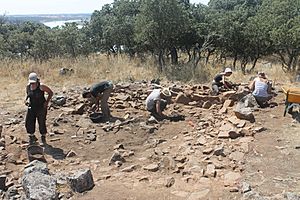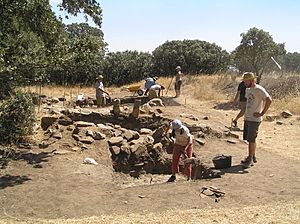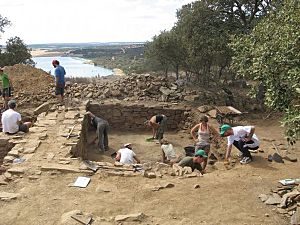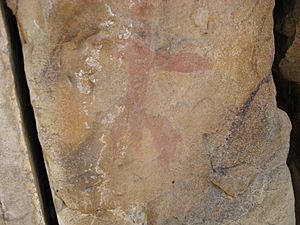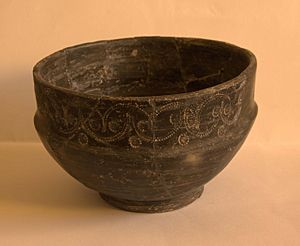El Castillón facts for kids
El Castillón is an exciting archaeological site in Spain. It is found in a small village called Santa Eulalia de Tábara, in the province of Zamora. This ancient place sits on top of a hill, right next to the Esla River.
The site is quite large, covering about 4 hectares (that's like 8 football fields!). People have lived here for a very long time. The oldest signs of life are from the Iron Age. But the most famous period is the Late Roman Era. Many pieces of beautiful red pottery from that time have been found. There are also items from the Early Modern period.
El Castillón was protected by a strong, U-shaped wall. This wall surrounded the settlement on three sides. On the fourth side, steep cliffs dropped down to the river. This made it a very safe place to live. Since 1985, the site has been protected by the Regional Government of Castilla y León. This is because amazing ancient cave paintings were found nearby.
Contents
Digging Up the Past: Archaeological Work
Archaeologists started digging at El Castillón in 2007. This work is part of a big project to study and share the ancient history of Zamora province. The main archaeologists leading the team were José Carlos Sastre Blanco and Óscar Rodríguez Monterrubio. Patricia Fuentes Melgar and Manuel Vázquez Fadón also joined the team later.
They have been digging almost every year since 2007, except for 2015. So far, they have explored three main areas. These include the strong walls that protected the site. They also looked at a special area where metal was worked. Finally, they explored a very large building that was used for storage.
Strong Walls: Defensive Systems
The settlement at El Castillón was surrounded by a huge wall. This wall was built in a U-shape to protect the village. It was made from very large, reddish stones called quartzite. An extra wall was built outside the main one for even more protection.
Archaeologists found part of the Late Roman wall near the main entrance. This entrance, called the eastern gatehouse, was extra strong. It had three special rooms, called casemates, built into the wall from the inside. Digging also showed how the wall was built. It had two outer faces filled with rough stones and earth. This strong wall was about 5 meters (16 feet) tall and 4 meters (13 feet) wide!
The Metalworking Area
In the northern part of the village, archaeologists found a special area. This was a place where people worked with metal. They discovered two complex structures that were used as metallurgical furnaces. These were like ovens for melting metal. They also found a forge, which is a workshop for shaping metal.
Even more exciting, a third furnace was found underneath the first two! This tells us that people used this area for metalworking for a very long time. The furnaces were oval-shaped with a stone base. They had an earthen dome that was built and then broken during the melting process. A small hole allowed access to the furnace.
Inside this area, many metal items were found. These included nails, knives, and tools. More than 50 kilograms (110 pounds) of iron slag were also discovered. Slag is the waste material left after melting metal. Scientists from the Complutense University studied the metal. They learned that the furnaces were used to get iron from raw ore. The raw materials likely came from the nearby Sierra de la Culebra mountains, which are only about 15 km away.
The Big Storehouse
In the middle-eastern part of the site, many buildings have been found. But only one has been fully dug up. It's called the "big storehouse" because of its huge size and what was found inside. This is the largest building in the village. It is 20 meters (65 feet) long and has 8 different rooms!
Each room seems to have been used for a different activity, but all were for storage. Some rooms were kitchens or pantries, with many animal bones found inside. Other rooms stored liquids like oil, wine, or honey in large containers called dolia. Some rooms stored grain or cereal in pottery. Other spaces were empty, used as corridors or courtyards. Some might have stored portable items like weapons or clothes.
The building was destroyed by a fire, but people moved back in later. A huge number of items have been found here. This makes El Castillón one of the most rewarding archaeological sites in Spain. Over 1000 pieces are found during each digging season!
Ancient Art: Cave Paintings
Just below the main site, in a shelter near the river, some amazing cave paintings were found. These are examples of "schematic art." This means the images are simple shapes and symbols. They show human-like figures, sticks, fingers, anchor shapes, circles, and other unclear designs.
The paintings are done in red color on quartzite rock. They are from the Bronze Age, which means they are more than 3000 years old!
What Was Found: Materials and Findings
Most of the items found at El Castillón are from the Late Roman period, around the 5th century AD. Some of the most important finds are pieces of pottery. This includes the shiny Late Hispano-Roman gloss pottery. There are also pieces of grey pottery with printed designs from the Early Medieval period.
These pottery pieces were pots, bowls, dishes, plates, jars, containers, and cups. Other finds include glass pieces and bronze jewelry like necklaces and rings. Metal items have also been found. One interesting piece is an osculatorio, a bronze stick with decorations. It was used for religious ceremonies or daily life. A special brooch, called a fibula type vyskov, from Eastern Europe (6th century) was also discovered. There are also bone tools and arrowheads made of iron and bronze.
The People Behind the Dig: Archaeologists and Volunteers
Many people have helped with the El Castillón research project. So far, 179 archaeologists, students, and volunteers have worked there. They come from all over Spain and from many countries around the world. For example, people have come from the United States, United Kingdom, Ireland, Italy, Portugal, France, Slovakia, Lithuania, Argentina, Tanzania, Canada, Australia, and Bolivia.
Images for kids
See also
 In Spanish: Castro de El Castillón para niños
In Spanish: Castro de El Castillón para niños


